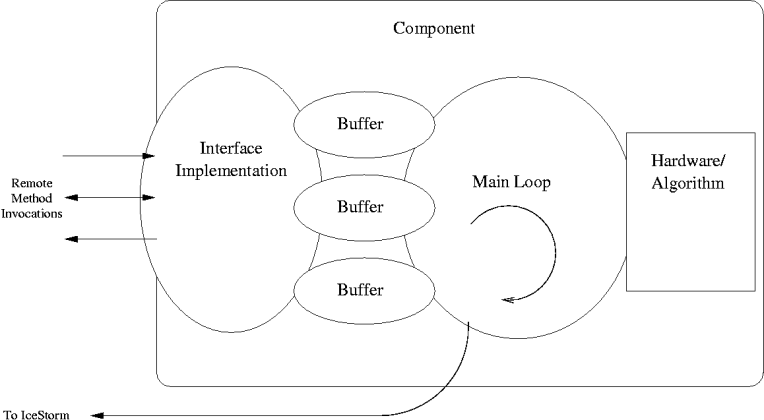INTRODUCTION
Overview
Download and Install
Quick Start
Documentation
Publications
NONFRAMEWORK CODE
Driver Interfaces
Drivers
Libraries
Utilities
FRAMEWORK CODE
Interfaces
Components
Libraries
Utilities
Full Software Listings
DEVELOPER
Tutorials
Examples
Dev Guide
Dashboard
PEOPLE
Contributors
Users
Project
Download
Mailing lists
Suggestions on the Internal Component Structure
- Note:
- Reviewed for release 2.0.0.
To reiterate, components can be developed in any way you choose. So long as they implement their interfaces, other components will be able to interoperate with them. This page contains suggestions for how to think about components, and how to write them using libOrcaIce. Several of the components in the repository are designed in this way.
A basic component template looks like this:

The main pieces are:
- Component
Derives from orcaice::Component.
This is the main class which instantiates and contains the other pieces. Deriving from orcaice::Component makes it easy to place it within either a stand-alone application or an IceBox Service.
To implement an orcaice::Component, the 'start()' and 'stop()' functions must be implemented.
- Interface Implementation
This class implements the methods defined in the Slice interface definition, ie it does the talking to the outside world. By convention, the implementation of interface MyInterface is called MyInterfaceI. The files are named myinterface.h and myinterface.cpp.
Remote Method Invocations arrive asynchronously from the outside world or from the Main Loop. Requests from the outside world can be answered using the information in the thread-safe buffers.
- Buffers
The buffers are instantiations of orcaice::PtrBuffer. They're thread-safe (to handle the concurrency issues presented by simultaneous access from MainLoop and the outside world), and are specially designed for Ice classes.
- Main Loop
Most (but not all) components need to do some work continuously. MainLoop is the class that holds the thread of execution (it derives from orcaice::Thread).
MainLoop's job is to be an intermediary between Hardware/Algorithm and Interface_Implementation (via the Buffers). A loop might look somthing like this (going vaguely clockwise in the figure):
- Check if new requests have arrived at the Buffers
- Hand the request(s) to the Hardware/Algorithm
- Read the data information generated by the Hardware/Algorithm (a blocking call)
- Send that data to the world via IceStorm
- Hand the data to the Buffers so the world can query it directly
- Goto step 1
- Hardware/Algorithm
This is the part that actually does the work. It may have its own internal threads.
The purpose of this design is try to separate (a) network communication, (b) sequence of control (including setup/shutdown, component life-cycle), and (c) the algorithm or hardware driver itself.

 1.4.5
1.4.5